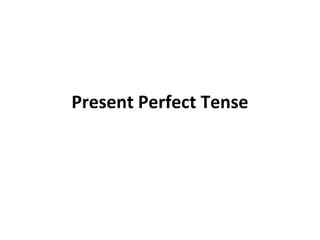
Learn the Structure and Uses of the Present Perfect Tense
- 2. • The present perfect tense is a rather important tense in English, but it gives speakers of some languages a difficult time. • That is because it uses concepts or ideas that do not exist in those languages. • In fact, the structure of the present perfect tense is very simple. • The problems come with the use of the tense.
- 3. In this lesson we look at the structure and use of the present perfect • Structure: how to make the present perfect tense • Use: when and why to use the present perfect tense • For and Since with the present perfect tense. What's the difference? • Present Perfect Quiz
- 4. NOTE • The present perfect tense is really a very interesting tense, and a very useful one. • Try not to translate the present perfect tense into your language. • Just try to accept the concepts of this tense and learn to "think" present perfect! You will soon learn to like the present perfect tense!
- 5. How do we make the Present Perfect Tense? The structure of the present perfect tense is: subject + auxiliary verb + main verb have past participle
- 6. Here are some examples of the present perfect tense: subject auxiliary verb main verb I have seen ET. You have eaten mine. She has not been to Rome. We have not played football. Have you finished? Have they done it?
- 7. Contractions with the present perfect tense • When we use the present perfect tense in speaking, we usually contract the subject and auxiliary verb. • We also sometimes do this when we write.
- 8. I have I've You have You've He has She has It has John has The car has He's She's It's John's The car's We have We've They have They've
- 9. Here are some examples: • I've finished my work. • John's seen ET. • They've gone home. He's or he's??? Be careful! The 's contraction is used for the auxiliary verbs have and be. For example, "It's eaten" can mean: • It has eaten. [present perfect tense, active voice] • It is eaten. [present tense, passive voice] It is usually clear from the context.
- 10. How do we use the Present Perfect Tense? This tense is called the present perfect tense. There is always a connection with the past and with the present. There are basically three uses for the present perfect tense: • experience • change • continuing situation
- 11. 1. Present perfect tense for experience • We often use the present perfect tense to talk about experience from the past. • We are not interested in when you did something. We only want to know if you did it:
- 12. I have seen ET. He has lived in Bangkok. Have you been there? We have never eaten caviar. past present !!! The action or In my head, I state was in the have a memory past. now. future
- 13. 2. Present perfect tense for change We also use the present perfect tense to talk about a change or new information: I have bought a car. past present - + Last week I didn't have a car. Now I have a car. future
- 14. John has broken his leg. past present + - Yesterday John had a good leg. future Now he has a bad leg. Has the price gone up? past present + - Was the price Is the price $1.70 $1.50 yesterday? today? future
- 15. The police have arrested the killer. past present - + Yesterday the killer was free. future Now he is in prison. Connection with past: the past is the opposite of the present. Connection with present: the present is the opposite of the past. Americans do not use the present perfect tense so much as British speakers. Americans often use the past tense instead. An American might say "Did you have lunch?", where a
- 16. 3. Present perfect tense for continuing situation • We often use the present perfect tense to talk about a continuing situation. • This is a state that started in the past and continues in the present (and will probably continue into the future). • This is a state (not an action). We usually use for or since with this structure.
- 17. I have worked here since June. He has been ill for 2 days. How long have you known Tara? past present future ---------------------------------------------------------- - - The situation started in the past. (It will probably It continues up to continue into the now. future.) Connection with past: the situation started in the past. Connection with present: the situation continues in the present.
- 18. For & Since with Present Perfect Tense • We often use for and since with the present perfect tense. • We use for to talk about a period of time - 5 minutes, 2 weeks, 6 years. • We use since to talk about a point in past time - 9 o'clock, 1st January, Monday.
- 19. for since a period of time a point in past time x------------ 20 minutes 6.15pm three days Monday 6 months January 4 years 1994 2 centuries 1800 a long time I left school ever the beginning of time
- 20. Here are some examples: • • • • • • I have been here for 20 minutes. I have been here since 9 o'clock. John hasn't called for 6 months. John hasn't called since February. He has worked in New York for a long time. He has worked in New York since he left school. For can be used with all tenses. Since is usually used with perfect tenses only.
